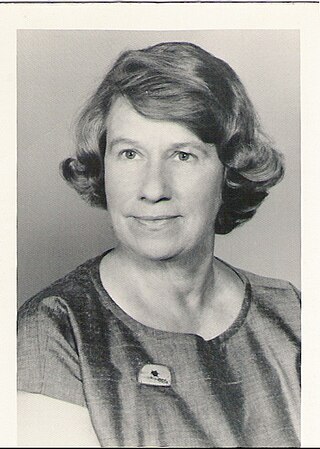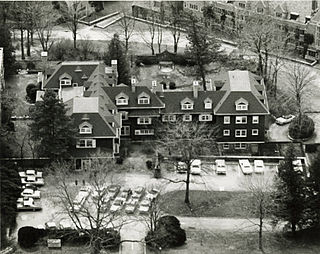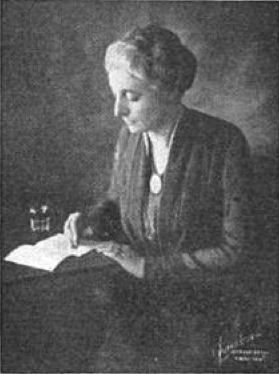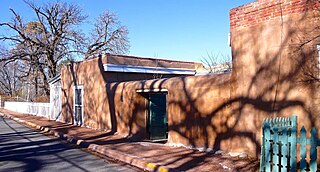Mary Patterson McPherson has served as the president of Bryn Mawr College (1978–1997), the vice president of the Andrew W. Mellon Foundation (1997–2007), and the executive officer of the American Philosophical Society (2007–2012). She is considered to be "a significant figure in American higher education and a leader in the education of women".

Charles Henry Dietrich was the 11th Governor of Nebraska. Dietrich began his career in mercantile pursuits and banking. After serving as governor, he was elected U.S. Senator from May 1, 1901 to March 3, 1905.

Dorothy Dunn Kramer was an American art instructor who created The Studio School at the Santa Fe Indian School.

Pablita Velarde born Tse Tsan was an American Pueblo artist and painter.
Mary Maples Dunn was an American historian. She served as the eighth president of Smith College for ten years beginning in 1985. Dunn was also the director of the Schlesinger Library from 1995 to 2000. She was acting president of Radcliffe College when it merged with Harvard University, and she became the acting dean of the newly created Radcliffe Institute for Advanced Study after the merger.
Dorothy Newkirk Stewart was an American printer, printmaker and artist.

The Bryn Mawr College Deanery was the campus residence of the first Dean and second President of Bryn Mawr College, Martha Carey Thomas, who maintained a home there from 1885 to 1933. Under the direction of Thomas, the Deanery was greatly enlarged and lavishly decorated for entertaining the college's important guests, students, and alumnae, as well as Thomas’ own immediate family and friends. From its origins as a modest five room Victorian cottage, the Deanery grew into a sprawling forty-six room mansion which included design features from several notable 19th and 20th century artists. The interior was elaborately decorated with the assistance of the American artist Lockwood de Forest and Louis Comfort Tiffany, de Forest's partner in the design firm Tiffany & de Forest, supplied a number of light fixtures of Tiffany glass. De Forest's design of the Deanery's so-called 'Blue Room' is particularly important as it is often considered one of the best American examples of an Aesthetic Movement interior, alongside the Peacock Room by James Abbott McNeill Whistler. In addition, John Charles Olmsted, of the Olmsted Brothers landscape design firm, designed a garden adjacent to the Deanery, which also contained imported works of art from Syria, China, and Italy. The Deanery's beauty and rich history established the Deanery as a cherished space on campus and an icon of Bryn Mawr College.

Anna Bell Lawther was a leader in the women's suffrage movement in the U.S. state of Iowa.

Gerónima Cruz Montoya (Potsunu) was an Ohkay Owingeh Pueblo artist and educator from New Mexico. She taught Native American artists at the Studio at the Santa Fe Indian School.
Eva Mirabal, also known as Eah-Ha-Wa (1920–1968) was a Native American painter, muralist, illustrator, and cartoonist from Taos Pueblo, New Mexico. Her primary medium was gouache, a type of watercolor.

Maria Chabot (1913–2001), was an advocate for Native American arts, a rancher, and a friend of Georgia O'Keeffe. She led the restoration of her house in Abiquiú, New Mexico, and took the photograph of O'Keeffe entitled Women Who Rode Away, in which the artist was on the back of a motorcycle driven by Maurice Grosser. Their correspondence was published in the book Maria Chabot—Georgia O'Keeffe: Correspondence 1941-1949.

El Zaguan, at 545 Canyon Rd. in Santa Fe, New Mexico, is a historic complex started in 1854. It was listed on the National Register of Historic Places in 2008. The listing included two contributing buildings, three contributing structures, two contributing objects, and a contributing site on 1.8 acres (0.73 ha).

Gertrude Sumner Ely was an American philanthropist, based in Philadelphia. She was decorated for her bravery during World War I.

Katrina Brandes Ely Tiffany was an American suffragist and philanthropist, from a prominent Philadelphia family.
Ellen Deborah Ellis was an American Professor of history and political science. She founded the political science department at Mount Holyoke College and was named its first chairman.

Rufina Vigil, also called Sah Wa, was an Puebloan-American painter from the Tesuque Pueblo tribe, part of the Eight Northern Pueblos. Active in the 1930s, she studied under Dorothy Dunn at the Santa Fe Indian School. At one time she worked as a drafter in Los Alamos, New Mexico. Vigil's paintings depict Tesuque life, including women gathering guaco and firing pottery. Her 1936 painting Mass at Fiesta is one of the earliest depictions of Catholic Church rituals by an indigenous North American painter.

Lorencita Atencio Bird, also called T'o Pove, was a Pueblo-American painter and textile artist from the Ohkay Owingeh Pueblo. She studied at the Santa Fe Indian School under Dorothy Dunn and exhibited her artwork across the country and in Europe. In particular, she is known for her embroidery designs, utilizing symbolic colors and motifs such as diamonds, butterflies, and the color gold. Her artworks can be found in private collections including the Margretta S. Dietrich Collection and in museums including the Heard Museum, the Gilcrease Museum, the Philbrook Museum of Art, and the Wheelwright Museum of the American Indian.

Martha Gibbons Thomas was an American politician, suffragist, and dairy farmer from Chester County. She became one of the first women elected to the Pennsylvania House of Representatives, belonging to a cohort of eight women representatives elected in 1922. Thomas won reelection in 1924. She did not seek a third term.

Acequia Madre House is a house built at 614 Acequia Madre in Santa Fe, in the U.S. state of New Mexico, in 1926 in the Territorial Revival style.

Mary Zelia Pease Philippides was an American archaeologist and librarian. She was librarian at the American School for Classical Studies in Athens from 1958 to 1971.















